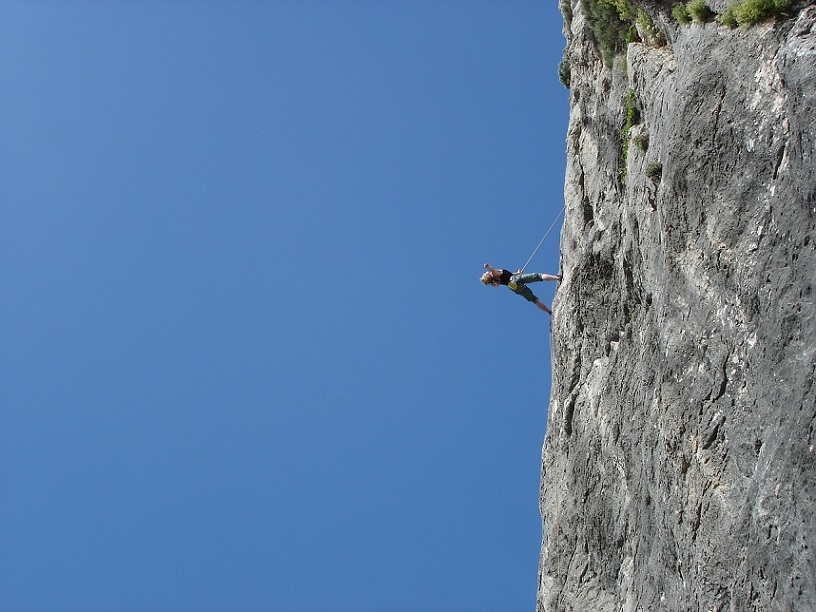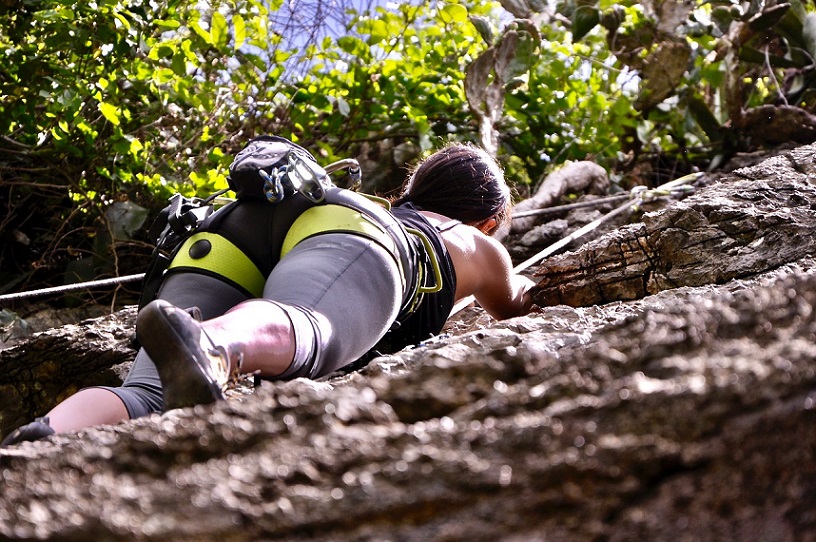Our climbing ropes are something that we generally take for granted.
When buying from a quality brand, it can be easy to assume that the rope can bear your weight. And while that’s probably a safe assumption, it’s good to understand why.
If you ever have worried about a rope’s ability to bear your weight, I have some good news:
Ropes that are commercially available from quality brands are subjected to rigorous tests that ensure they can safely bear normal rock climbing weights.
In fact, these ropes generally have the ability to bear a much higher weight capacity than you’ll ever be able to put on them.
That being said, however, there are several factors that can influence how much weight your rope can bear. From the type of rope to the type of weight being supported, you must consider several aspects before determining just how much weight your rope can bear.
I’ll walk you through the important information you should know about the strength of your rock climbing rope.
Be aware, however, that this advice is for general information purposes only. If you’re in doubt about the strength or the capacity of your rope, be sure to contact a professional. Due to the unique circumstances you could be facing, you may need a more specific evaluation to ensure your rope’s safety.
With this in mind, let’s take a closer look at the information you need to know about determining the strength of your rock climbing rope.

Fundamental information
Before we look closer at the details that determine the strength of your rope, it’s important to establish a few fundamentals.
For starters, it’s of note that many rope-strength tests do not test ropes in isolation. Instead, they are tested in conjunction with rope climbing devices. This allows for a more accurate result, as the strength of your rope will never be separated from these influencers.
It’s also important to understand what your rope is made of.
In today’s market, most are made up of polyamide—an extremely tough material that better allows for the absorption of forces, including fall and shock absorption.
Because of this, climbing ropes made today are generally safe. This, coupled with rigorous quality tests, helps ensure that your rope can stand up to just about any climb.
But as any rock climber knows, there’s more to the story than meets the eye.
Depending on the type of climbing you’re doing or the rope you’re using, there may be certain additional considerations you’ll have to make.
Different Rope Types
Different types of rope have different weight capacity. Below, we’ll examine the difference in weight capacity between three of the most common types of climbing ropes.
Dynamic vs Static Ropes
Before going into the three different types of ropes, do note that there are two overarching categories that can be used to classify all ropes, no matter the type: dynamic and static.
Static ropes are those that do not stretch under the weight of any load—making them unsuitable for rock climbing.
Dynamic ropes do stretch to varying degrees under different loads. This makes them much more appropriate for rock climbing purposes.
The different kinds of rope we’ll discuss below fall under this dynamic category. This does not mean, however, that we can’t determine a static weight for each.
- Single Ropes
Single ropes are the most common type of rope. As you can guess from the name, single ropes consist of one rope.
Single ropes come in different lengths and diameters, which can influence the overall weight capacity.
When using a single rope technique, the diameter of the rope is generally wider, as one rope will be doing all of the leg work.
- Half Ropes
Half ropes are thinner than those of the single variety.
When using a half rope technique, the load is distributed over two thinner ropes that are attached to different pieces of equipment.
This is popular among some rock climbers, especially those who undertake more difficult climbs.
Because of this, it can be more difficult to determine the weight load of one rope in isolation, as the weight and the forces are distributed across two thinner ropes.
- Twin Ropes
Much in the same vein as half ropes, twin ropes differ in that the two ropes used are attached to one central piece of equipment and location.
This can shift the way in which the weight is distributed. With this in mind, however, it must be noted that both ropes—which are still thinner than single ropes—bear part of the load.
Static vs Dynamic Weight
With this in mind, it’s time to get into the nitty-gritty details about what can influence the weight-load capacity for your rope.
In order to do so, you must understand the difference between static and dynamic weight.
Static in this sense refers to a weight that’s not moving. For instance, it may be that you’re hanging on the rope and not moving. There’s a maximum static weight that your rope can hold without breaking.
The static weight that a rope can hold is going to be higher than its dynamic capacity.
The dynamic weight refers to moving weight. Let’s say that you suffer a fall while climbing. The combined force of the fall will add to the weight. For this reason, it’s important that you make sure that the dynamic weight is enough to support you and your load in case of a fall.
As we look at the weight capacity that your rope can hold, we’ll consider both the static and dynamic weights.
Now, let’s see what factors can directly influence the weight-bearing capacity of a rope.
Factors Influencing Weight Capacity
No matter what type of rope you’re using, the following factors can influence how much weight it can hold.
- Rope Diameter
As we’ve seen, different types of ropes have various diameters.
In fact, the diameter of climbing ropes can differ even among categories.
Single ropes, for instance, can vary in diameter from 9.4mm to 11mm, with an average of 10.5mm.
For this reason, we’ll take an extra in-depth look at the ropes of 10.5mm.
For now, I want to note that ropes of a higher diameter typically bear greater loads. The bigger the diameter, the more weight it can bear, but there are several reasons as to why a rock climber may choose to invest in a rope that’s thinner.
Many rock climbers, for instance, prefer to sacrifice the extra durability in favor of a lightweight alternative. This can help make for easier handling on more difficult climbs.
Keep in mind, however, that you should always make sure that your rope is good enough to bear the load you need.
- Knots
Though you may be adding knots for your safety—and you should—be aware that different knots can influence the weight capacity of your rope.
That’s right—knots will decrease the overall weight that your ropes can support.
The good news is that the strength of the rope generally far outweighs any knot that you can tie into it, so you can be reasonably certain that the knots you’re tying won’t put you at any increased risk.
Lyon Equipment Limited conducted a comprehensive study that examined the impact of different kinds of knots on rock climbing ropes.
Their findings are of integral importance in determining how strong your rope will be:
- Double Figure-of Eight Knots—These knots are common in rock climbing and were found to retain between 66% and 77% of a rope’s full strength.
- Barrel Knot—These common knots are used to tie to the carabiner. Barrel knots were found to keep 67% to 77% of the rope’s strength.
- Double Overhand Knots—These knots were found to only retain between 58% to 68% of a rope’s strength.
The physics behind this can be quite complicated, so it’s better to simply remember this:
No matter what knots you use, you’re weakening your rope, and depending on which one you use, you could be reducing the weight even more.
Knowing this, you may be wondering how safe ropes are once you’ve tied a knot in them.
Will they still be able to support your weight and the weight of your loads?
Generally speaking, yes. Though, as noted, if you’re unsure about the quality of your rope, make sure that you seek professional advice.
The truth is that studies have found that the strength of the rope far surpasses the strength of knots, meaning that they’re still safe for use.
So just how strong are ropes?
Let’s get to the part that I know you’ve all been waiting for.
Estimated Weight Capacity
It must be noted before we go into the particulars, that because of the several factors listed above, the actual strength of your rope may be different. The figures here are only estimates gathered from the Lyon Equipment Limited’s comprehensive study on a specific set of tested ropes.
Of note, these ropes are all of a diameter of 10.5mm.
Let’s take a look at some standard ultimate strengths of common 10.5mm ropes:
1. Edelrid Ropes
New, unused Edelrid ropes of 10.5mm can be expected to support a weight of up to 28.4—28.9kN.
Edelrid ropes that have undergone light glazing can typically withstand a force of 28-30kN.
Finally, Edelrid ropes with nominal damage can withstand a force of up to 27kN.
2. Beal Ropes
Beal Ropes with a diameter of 10.5mm and only nominal damage can withstand forces up to 24.5kN.
3. Marlow Ropes
Marlow ropes with a diameter of 10.5mm and some light glazing faired slightly better, withstanding forces up to 31kN.
When looking at a rope’s ability to withstand dynamic forces, another factor comes into play: impact force.
In this regard, dynamic ropes of wider diameters do more to combat impact forces.
For instance, the Apollo rope manufactured by Beal can withstand an impact force of 7.5kN. This impact force can combine with the weight and put further strain on the rope.
While the length of the rope doesn’t have a direct influence on its strength, it does affect the impact force of a fall.
Shorter ropes have a lower ability to absorb the shock of a fall, meaning that the impact force will be greater.
And this can be compounded with several different factors.
Let’s take a look at the Beal Gully. Quite possibly the thinnest rope on the market, the Gully clocks in at just 7.3mm.
As noted, the weight capacity and impact force also depend on the type of rope being used.
We already saw the impact force on a single rope with the Beal Apollo.
How does this compare to half and twin rope varieties of the Gully?
A look at this reveals important information: half-ropes have a lower impact force than twin ropes.
The Beal Gully’s half-rope impact force is 5.2kN, while the twin variety sits at 7.9kN. Keep this in mind when selecting the rope you wish to use.
Other Tips to Consider
Finally, make sure that you have a full understanding of your rope.
Newer ropes, for instance, will likely have a higher static weight and dynamic weight capacity. The more you use your rope, the weaker they will become.
Additionally, the more impact force they’ve absorbed, the weaker they will be. This means that if you’ve had multiple falls, your rope will likely be weaker than the standard.
It’s always good to routinely check your ropes to make sure that they’re in the best-possible condition. If you’re worried about the wear on your rope, be on the safe side and invest in a new one.
By making sure that your rope is in tip-top condition, you can get the most out of it in terms of strength. Not to mention, you’ll have a much greater peace of mind as you start to make your climbs.
Keep these tips in mind as you evaluate the strength of both the ropes you already own—and those you wish to buy.






